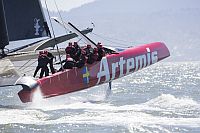 Wired Magazine ran a weirdly prophetic article that appears to have been published almost immediately before the tragic death of British Olympian, Andrew Simpson, in the capsize of the Swedish Artemis Racing AC72 catamaran yesterday in San Francisco Bay. In the article, titled “The Boat That Could Sink the America’s Cup” Adam Fisher suggests that the AC72 catamarans, in which the race will be sailed and on which Simpson died, may be too expensive, too dangerous and too fragile.
Wired Magazine ran a weirdly prophetic article that appears to have been published almost immediately before the tragic death of British Olympian, Andrew Simpson, in the capsize of the Swedish Artemis Racing AC72 catamaran yesterday in San Francisco Bay. In the article, titled “The Boat That Could Sink the America’s Cup” Adam Fisher suggests that the AC72 catamarans, in which the race will be sailed and on which Simpson died, may be too expensive, too dangerous and too fragile.
The article focuses primarily on the capsize of an Oracle AC72 last October, which at the time was dismissed by some as “a freak chain of events” while others worried that such a catastrophic capsize might happened again . Fisher quotes Paul Cayard, CEO and tactician of Artemis Racing who said “It will be a miracle if we get through the summer without it happening to somebody… We’re going to start pushing harder, we are going to race, and those kinds of boats — catamarans — tip over.” Cayard’s prediction proved sadly accurate when the Artemis Racing AC72 capsized yesterday and killed Olympic gold medalist, Andrew Simpson.
The cause of the Artemis capsize does appear to be different from the previous capsize of the Oracle boat, however, which took place under much windier and choppier sea conditions. The Artemis AC72 appears to have simply broken apart due to some sort of structural weakness. As reported last night by Adam Fisher in Wired, What Went Wrong in the Deadly America’s Cup Crash, in an update to his previous article:
Preliminary reports indicate Artemis’s boat didn’t capsize because the sailors were pushing too hard or made a mistake, as was the case with Team Oracle. The problem was with the boat itself, either faulty engineering or faulty construction. The boat simply broke apart under sail, folded, then flipped. The Artemis boat has had a history of cracking and problems with the carbon fiber used in the twin “beams” — the two girders that lash the two narrow hulls together. The boat had been in and out of the shed numerous times in an attempt to correct those problems. Today, however, the forward beam — the girder in front of the sail — gave way during a practice run. The two hulls, no longer connected, began sailing in slightly different directions. This caused one hull to snap just forward of the aft beam, and the mast, held up by high-tension rigging connected to the front of the hulls, simply fell over. The boat began to cartwheel, ultimately trapping Simpson underneath and drowning him.
The Oracle crash last October happened in much worse conditions, and in much rougher seas. The team was risking a turn in a twenty-five knot wind, with an ebb tide that was running at six knots. The new America’s Cup boats are powered with a solid wing instead of a soft sail, which makes them very efficient, but it also means that they cannot be de-powered. The turning maneuver in high winds is greatly feared by sailors, who call it the “death zone.” Oracle’s boat was blown over mid turn, landing on its side. In that case, the rigging securing the wing held, and the boat didn’t fully flip, allowing all of the sailors to exit safely. The boat subsequently broke up when it was swept out the Golden Gate by the tide.
With the advent of high-speed catamarans, the once gentlemanly sport of yacht racing has taken on aspects of a demolition derby. The breaking up of the Artemis AC72 resulting in the death of Andrew Simpson makes the previous capsize of the Oracle AC72 seem tame by comparison. Will the remaining AC72s hold together through the next round of races beginning in July? Only time will tell.
The post Is the AC72 the Boat That Could Sink the America’s Cup? appeared first on Old Salt Blog.